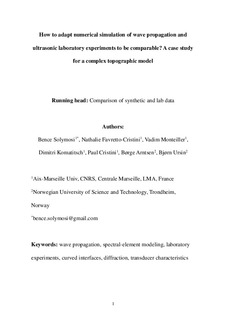| dc.contributor.author | Solymosi, Bence | |
| dc.contributor.author | Favretto-Cristini, Nathalie | |
| dc.contributor.author | Monteiller, Vadim | |
| dc.contributor.author | Komatitsch, Dimitri | |
| dc.contributor.author | Cristini, Paul | |
| dc.contributor.author | Arntsen, Børge | |
| dc.contributor.author | Ursin, Bjørn | |
| dc.date.accessioned | 2019-06-03T14:09:01Z | |
| dc.date.available | 2019-06-03T14:09:01Z | |
| dc.date.created | 2019-01-17T15:30:05Z | |
| dc.date.issued | 2018 | |
| dc.identifier.citation | Geophysics. 2018, 83 (4), T195-T207. | nb_NO |
| dc.identifier.issn | 0016-8033 | |
| dc.identifier.uri | http://hdl.handle.net/11250/2599771 | |
| dc.description.abstract | Numerical methods are widely used in seismic exploration to simulate wave propagation; however, the algorithms are based on various assumptions. The accuracy of numerical simulations is of particular interest in the case of realistic geologic setups. The direct comparison of numerical results can have limitations, and an alternative approach can be the comparison of synthetic results with experimental data, obtained for a small-scale physical model in laboratory conditions. Laboratory experiments are repeatable and provide high-quality data for a known configuration. We have developed a possible workflow to adapt the numerical simulations and the laboratory experiments to each other, such that the two can be easily compared with high accuracy. The model is immersed in a water tank, and a conventional pulse-echo technique is used to collect the reflection data in zero-offset and offset configurations. We use a spectral-element method for the numerical modeling. The model geometry is implemented using a nonstructured mesh, and the computational cost can be optimized using larger elements and higher-order basis functions. The real source transducer characteristics are implemented based on a new approach: laboratory characterization of the impulse response, followed by an inversion step to obtain a numerically equivalent source. The comparison of the zero-offset synthetic and laboratory results reveals an excellent fit in terms of arrival time, phase, and amplitude. Minor amplitude mismatches may be attributed to the noise recorded in the laboratory data and to the possible inaccuracy of the proposed source implementation. Comparison of the simulated and laboratory offset traces also exhibits a good fit in general, but with significantly less accuracy for some arrivals than in the zero-offset case. This can be mainly attributed to the inaccuracies of the transducer positions during the laboratory measurements combined with the strong topography of the model. | nb_NO |
| dc.language.iso | eng | nb_NO |
| dc.publisher | Society of Exploration Geophysicists | nb_NO |
| dc.title | How to adapt numerical simulation of wave propagation and ultrasonic laboratory experiments to be comparable — A case study for a complex topographic model | nb_NO |
| dc.type | Journal article | nb_NO |
| dc.type | Peer reviewed | nb_NO |
| dc.description.version | acceptedVersion | nb_NO |
| dc.source.pagenumber | T195-T207 | nb_NO |
| dc.source.volume | 83 | nb_NO |
| dc.source.journal | Geophysics | nb_NO |
| dc.source.issue | 4 | nb_NO |
| dc.identifier.doi | 10.1190/geo2017-0536.1 | |
| dc.identifier.cristin | 1659595 | |
| dc.description.localcode | © 2018. This is the authors' accepted and refereed manuscript to the article. The final authenticated version is available online at: http://dx.doi.org/10.1190/geo2017-0536.1 | nb_NO |
| cristin.unitcode | 194,64,90,0 | |
| cristin.unitname | Institutt for geovitenskap og petroleum | |
| cristin.ispublished | true | |
| cristin.fulltext | preprint | |
| cristin.qualitycode | 2 | |
